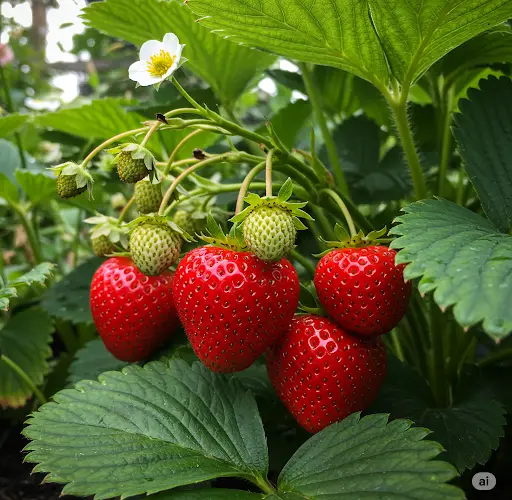Strawberries are one of the most popular and rewarding fruits to grow at home. Their sweet, juicy berries are a favorite treat for many gardeners. To enjoy a bigger harvest each season, propagating your strawberry plants effectively is essential. Propagation not only increases your number of plants but also rejuvenates your patch, ensuring continued productivity year after year.
This article explores the most proven and practical methods to propagate strawberries, whether you want to expand your garden or replace older, less vigorous plants.
Why Propagate Strawberries?
Strawberry plants have a limited productive lifespan—usually three to four years—after which yields decline. Propagation allows you to:
-
Multiply your plants without buying new ones
-
Replace older plants with vigorous young runners
-
Maintain disease-free crops by selecting healthy parent plants
-
Increase your strawberry harvest sustainably and economically
Understanding Strawberry Growth Habits
Strawberries reproduce naturally through runners, also called stolons. These are horizontal stems that grow outward from the main plant, developing small plantlets at nodes. These plantlets root in the soil and form new strawberry plants, genetically identical to the parent.
By managing and encouraging runner production, you can easily propagate strawberries in your garden.
Method 1: Propagating Using Runners
This is the simplest and most common method to propagate strawberries.
How to do it:
-
Select healthy mother plants: Choose disease-free, vigorous plants producing healthy runners.
-
Prepare the soil: Keep the soil moist and rich in organic matter. Clear weeds and loosen soil where runners will root.
-
Guide runners: As runners grow, gently place their plantlets on prepared soil areas or into pots filled with potting mix. You can use small pins, staples, or even small stones to hold the runner in place.
-
Wait for rooting: After a few weeks, roots will form at the base of the plantlet.
-
Sever the runner: Once the new plantlet has established strong roots, cut the runner stem connecting it to the mother plant.
-
Transplant if needed: If plantlets rooted in pots, transplant them to the garden after hardening off.
Tips:
-
Allow each runner plantlet to root before detaching.
-
Remove excess runners if you want to focus plant energy on fruit production.
-
Propagate during the growing season for best success.
Method 2: Propagation by Division
Older strawberry plants can be divided to produce multiple new plants, especially if they have grown large and crowded.
Steps:
-
Dig up the entire plant: Carefully lift the strawberry clump from the soil.
-
Separate crowns: Using a sharp knife or hands, divide the plant into sections. Each section should have healthy roots and at least one crown (growing point).
-
Replant divisions: Plant the divisions immediately in prepared soil with good drainage.
-
Water well: Keep the soil moist while the new divisions establish.
This method rejuvenates older strawberry patches and spreads the plants more efficiently.
Method 3: Propagation from Seed
Growing strawberries from seed is less common and more time-consuming but useful for breeding new varieties or growing heirloom types.
How to propagate from seed:
-
Harvest fresh seeds: Collect ripe strawberry seeds from healthy fruits.
-
Stratify seeds: To break dormancy, refrigerate seeds wrapped in a moist paper towel for 3-4 weeks.
-
Sow seeds: Plant seeds in seed trays or pots filled with seed-starting mix. Press seeds lightly on the soil surface without covering deeply.
-
Provide warmth and light: Keep seeds at about 60-70°F (15-21°C) with plenty of indirect light.
-
Maintain moisture: Mist regularly to keep the soil moist but not soggy.
-
Transplant seedlings: When seedlings have several leaves, transplant them carefully into larger pots or the garden.
Growing from seed requires patience, as it may take several months before plants mature and fruit.
Additional Tips for Successful Propagation
-
Choose disease-free stock: Healthy plants produce better runners and seeds.
-
Timing matters: Propagate in spring or early summer for optimal root and plantlet development.
-
Use quality soil: Fertile, well-drained soil promotes vigorous root growth.
-
Avoid overcrowding: Provide enough space for new plants to grow without competition.
-
Fertilize moderately: Use balanced fertilizers during establishment but avoid overfeeding which can harm young plants.
-
Protect young plants: Shield new propagations from pests and extreme weather until established.
Troubleshooting Common Propagation Issues
-
Poor rooting: May be caused by dry soil or poor contact with soil. Keep the area moist and ensure runners are firmly placed.
-
Diseased runners: Avoid propagating from unhealthy plants to prevent spreading disease.
-
Weak plantlets: Thin overcrowded runners and focus resources on the strongest plantlets.
-
Pests: Monitor for slugs, aphids, and other pests that may damage young plants.
Final Thoughts
Propagating strawberries is a rewarding and cost-effective way to expand your garden and boost your harvest. Whether you use the simple runner method, divide mature plants, or grow from seed, these propagation techniques help maintain a healthy, productive strawberry patch season after season.
By understanding your strawberry plants’ growth habits and giving proper care to new propagations, you ensure more luscious berries on your table and a flourishing garden year after year.



